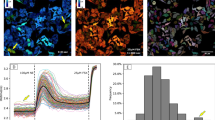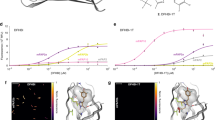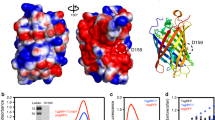Abstract
Here we describe protocols for preparing and using fluorescent probes that respond to conformational changes by altered Foerster resonance energy transfer (FRET) efficiencies upon phosphorylation or, in principle, other posttranslational modifications (PTMs). The sensor protein, a truncated version of pleckstrin, is sandwiched between short-wavelength-excitation green fluorescent protein (GFP2) and yellow fluorescent protein (EYFP). As a result of complex conformational changes of the protein upon phosphorylation, the introduction of a second PTM consensus sequence bestows sensitivity to a second modification and yields a dual-parameter probe. The first phase of the protocol lays out the cloning strategy for single- and dual-parameter FRET sensors, including the construction of a versatile platform into which different consensus sequences may be inserted to create diverse probes. Protocols for fluorescence microscopy of the probes in living cells and image processing are also described. Probe preparation takes 7 d; microscopy and image processing take 2 h.
This is a preview of subscription content, access via your institution
Access options
Subscribe to this journal
Receive 12 print issues and online access
$259.00 per year
only $21.58 per issue
Buy this article
- Purchase on Springer Link
- Instant access to full article PDF
Prices may be subject to local taxes which are calculated during checkout






Similar content being viewed by others
References
Zhang, J., Campbell, R.E., Ting, A.Y. & Tsien, R.Y. Creating new fluorescent probes for cell biology. Nat. Rev. Mol. Cell Biol. 3, 906–918 (2002).
Miyawaki, A. Visualization of the spatial and temporal dynamics of intracellular signaling. Dev. Cell 4, 295–305 (2003).
Wouters, F.S., Verveer, P.J. & Bastiaens, P.I.H. Imaging biochemistry inside cells. Trends Cell Biol. 11, 203–211 (2001).
Griesbeck, O. Fluorescent proteins as sensors for cellular functions. Curr. Opin. Neurobiol. 14, 636–641 (2004).
Hoffmann, C. et al. A FlAsH-based FRET approach to determine G-protein coupled receptor activation in living cells. Nat. Methods 2, 171–176 (2005).
Rothman, D.M., Shults, M.D. & Imperiali, B. Chemical approaches for investigating phosphorylation in signal transduction networks. Trends Cell Biol. 15, 502–510 (2005).
Yeh, R.H., Yan, X.W., Cammer, M., Bresnick, A.R. & Lawrence, D.S. Real time visualization of protein kinase activity in living cells. J. Biol. Chem. 277, 11527–11532 (2002).
Nguyen, A., Rothman, D.M., Stehn, J., Imperiali, B. & Yaffe, M.B. Caged phosphopeptides reveal a temporal role for 14-3-3 in G1 arrest and S-phase checkpoint function. Nat. Biotechnol. 22, 993–1000 (2004).
Adams, S.R., Harootunian, A.T., Buechler, Y.J., Taylor, S.S. & Tsien, R.Y. Fluorescence ratio imaging of cyclic-amp in single cells. Nature 349, 694–697 (1991).
Violin, J.D., Zhang, J., Tsien, R.Y. & Newton, A.C. A genetically encoded fluorescent reporter reveals oscillatory phosphorylation by protein kinase C. J. Cell Biol. 161, 899–909 (2003).
Zacharias, D. Sticky caveats in an otherwise glowing report: oligomerizing fluorescent proteins and their use in cell biology. Sci. STKE, PE23 (2002).
Schleifenbaum, A., Stier, G., Gasch, A., Sattler, M. & Schultz, C. Genetically encoded FRET probe for PKC activity based on pleckstrin. J. Am. Chem. Soc. 126, 11786–11787 (2004).
Brumbaugh, J., Schleifenbaum, A., Gasch, A., Sattler, M. & Schultz, C. A dual parameter FRET probe for measuring PKC and PKA activity in living cells. J. Am. Chem. Soc. 128, 24–25 (2006).
Zimmermann, T., Rietdorf, J., Girod, A., Georget, V. & Pepperkok, R. Spectral imaging and linear un-mixing enables improved FRET efficiency with a novel GFP2-YFP FRET pair. FEBS Lett. 531, 245–249 (2002).
Zhang, J.H., Chung, T.D.Y. & Oldenburg, K.R. A simple statistical parameter for use in evaluation and validation of high throughput screening assays. J. Biomol. Screening 4, 67–73 (1999).
Sittampalam, G.S. et al. Design of signal windows in high throughput screening assays for drug discovery. J. Biomol. Screening 2, 159–169 (1997).
Author information
Authors and Affiliations
Corresponding author
Ethics declarations
Competing interests
The authors declare no competing financial interests.
Rights and permissions
About this article
Cite this article
Brumbaugh, J., Schleifenbaum, A., Stier, G. et al. Single- and dual-parameter FRET kinase probes based on pleckstrin. Nat Protoc 1, 1044–1055 (2006). https://doi.org/10.1038/nprot.2006.177
Published:
Issue Date:
DOI: https://doi.org/10.1038/nprot.2006.177
This article is cited by
Comments
By submitting a comment you agree to abide by our Terms and Community Guidelines. If you find something abusive or that does not comply with our terms or guidelines please flag it as inappropriate.



